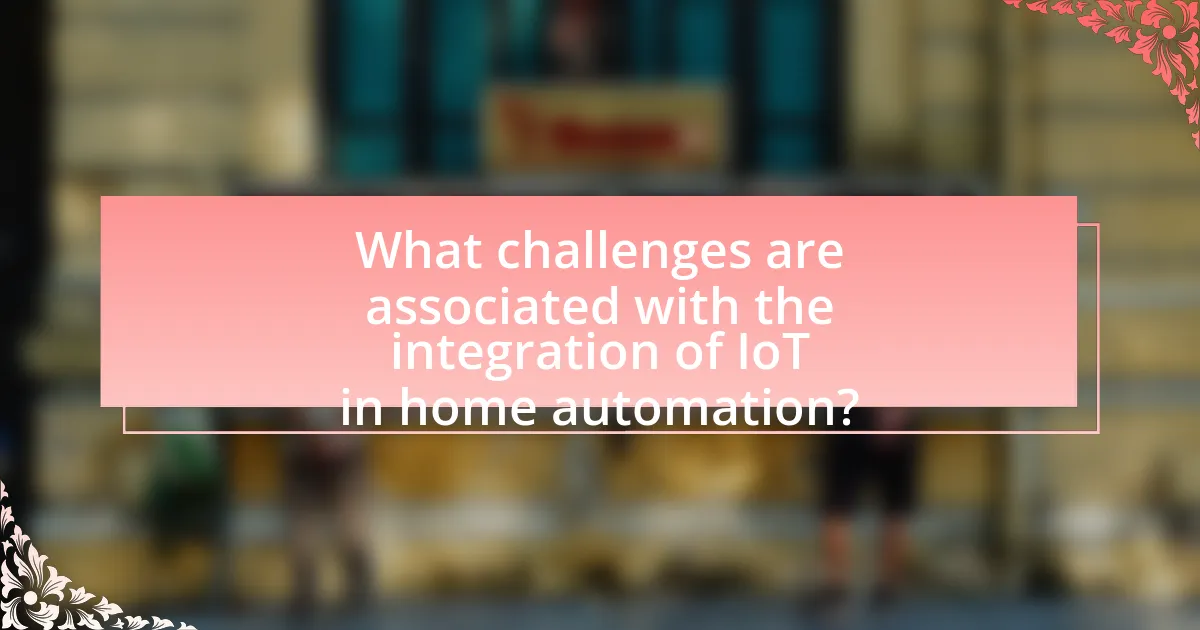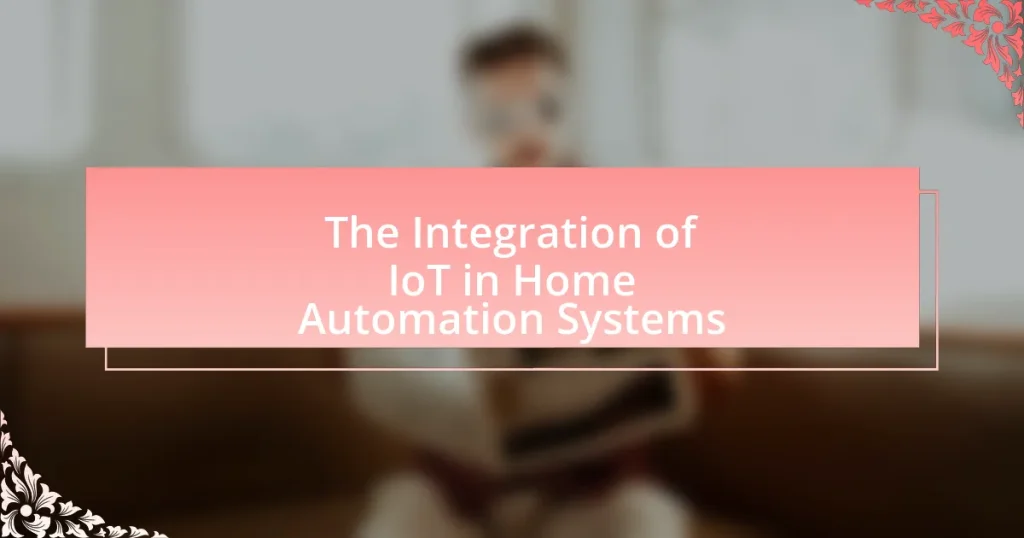The integration of Internet of Things (IoT) technology in home automation systems enables remote control and monitoring of household devices, enhancing convenience, energy efficiency, and security. Key components include smart devices, communication protocols, cloud computing, and data analytics, which work together to create a seamless automation ecosystem. The article explores how IoT enhances home automation through real-time data exchange, the types of devices commonly used, and the benefits of improved energy management and security. Additionally, it addresses challenges such as security vulnerabilities, interoperability issues, and data privacy concerns, while highlighting future trends and best practices for effective integration.

What is the Integration of IoT in Home Automation Systems?
The integration of IoT in home automation systems refers to the incorporation of Internet of Things technology to enable remote control and monitoring of household devices. This integration allows devices such as lights, thermostats, security cameras, and appliances to communicate with each other and be managed through a centralized platform, often via smartphones or voice assistants. According to a report by Statista, the global smart home market is projected to reach $174 billion by 2025, highlighting the growing adoption of IoT in home automation. This technology enhances convenience, energy efficiency, and security for homeowners, demonstrating its significant impact on modern living environments.
How does IoT enhance home automation systems?
IoT enhances home automation systems by enabling seamless connectivity and communication between devices, allowing for remote monitoring and control. This integration facilitates real-time data exchange, which improves energy efficiency, security, and convenience. For instance, a study by Statista in 2023 reported that smart home devices connected via IoT can reduce energy consumption by up to 30%, demonstrating the tangible benefits of IoT in optimizing home automation.
What are the key technologies involved in IoT for home automation?
The key technologies involved in IoT for home automation include sensors, actuators, communication protocols, cloud computing, and data analytics. Sensors collect data from the environment, such as temperature and motion, while actuators perform actions based on that data, like adjusting a thermostat or turning on lights. Communication protocols, such as Wi-Fi, Zigbee, and Bluetooth, enable devices to connect and communicate with each other and with a central hub. Cloud computing provides the infrastructure for data storage and processing, allowing for remote access and control of home automation systems. Data analytics processes the collected data to optimize performance and enhance user experience. These technologies work together to create a seamless and efficient home automation ecosystem.
How do IoT devices communicate within a home automation system?
IoT devices communicate within a home automation system primarily through wireless protocols such as Wi-Fi, Zigbee, Z-Wave, and Bluetooth. These protocols enable devices to send and receive data, allowing for seamless interaction and control. For instance, Wi-Fi allows devices to connect to the internet and communicate with cloud services, while Zigbee and Z-Wave are designed for low-power, short-range communication, making them ideal for smart home devices. The interoperability of these protocols facilitates the integration of various devices, enhancing the overall functionality of the home automation system.
What are the primary components of IoT in home automation?
The primary components of IoT in home automation include smart devices, communication protocols, cloud computing, and data analytics. Smart devices, such as smart thermostats, lights, and security cameras, enable automation and remote control of home functions. Communication protocols, like Wi-Fi, Zigbee, and Bluetooth, facilitate connectivity between devices and the internet. Cloud computing provides the infrastructure for data storage and processing, allowing for remote access and control. Data analytics enables the interpretation of data collected from devices, enhancing user experience and system efficiency. These components work together to create a seamless and intelligent home automation system.
What types of devices are commonly used in IoT home automation?
Commonly used devices in IoT home automation include smart thermostats, smart lighting systems, smart locks, security cameras, and smart appliances. Smart thermostats, such as the Nest Learning Thermostat, allow users to control heating and cooling remotely, optimizing energy usage. Smart lighting systems, like Philips Hue, enable users to adjust lighting through mobile apps or voice commands. Smart locks, such as August Smart Lock, provide keyless entry and remote access control. Security cameras, including Ring and Arlo, offer real-time monitoring and alerts. Smart appliances, like smart refrigerators and washing machines, enhance convenience and efficiency in daily tasks. These devices collectively contribute to a more connected and automated home environment.
How do sensors and actuators function in this context?
Sensors detect environmental changes, such as temperature, light, or motion, and convert these changes into signals that can be processed. In home automation systems, these signals inform the system about the current state of the environment, enabling it to make decisions. Actuators, on the other hand, receive commands from the system based on sensor data and perform physical actions, such as adjusting a thermostat, turning lights on or off, or locking doors. This interaction between sensors and actuators allows for automated responses to changes in the home environment, enhancing convenience and energy efficiency. For example, a motion sensor can trigger an actuator to turn on lights when someone enters a room, demonstrating the practical application of this integration in home automation.
What benefits does the integration of IoT provide in home automation?
The integration of IoT in home automation provides enhanced convenience, energy efficiency, and improved security. By connecting devices such as smart thermostats, lighting systems, and security cameras to the internet, homeowners can remotely control and monitor their environments through smartphones or voice assistants. For instance, a study by the International Energy Agency found that smart home technologies can reduce energy consumption by up to 30%, demonstrating significant cost savings and environmental benefits. Additionally, IoT-enabled security systems offer real-time alerts and remote access, increasing safety and peace of mind for residents.
How does IoT improve energy efficiency in homes?
IoT improves energy efficiency in homes by enabling real-time monitoring and control of energy consumption through connected devices. Smart thermostats, for instance, learn user habits and adjust heating and cooling accordingly, leading to energy savings of up to 10-15% annually. Additionally, IoT sensors can detect when rooms are unoccupied and automatically turn off lights and appliances, further reducing unnecessary energy use. According to a study by the American Council for an Energy-Efficient Economy, homes equipped with IoT technology can achieve energy savings of 20-30% compared to traditional homes, demonstrating the significant impact of IoT on energy efficiency.
What role does IoT play in enhancing home security?
IoT significantly enhances home security by enabling real-time monitoring and control of security devices. Smart cameras, motion sensors, and alarms connected through IoT networks allow homeowners to receive instant alerts and access live feeds from their devices remotely. According to a report by Statista, the global smart home security market is projected to reach $78.9 billion by 2024, indicating a growing reliance on IoT technologies for home safety. This integration not only improves response times to potential threats but also allows for automation, such as locking doors or turning on lights when unusual activity is detected, thereby deterring intruders.

What challenges are associated with the integration of IoT in home automation?
The integration of IoT in home automation faces several challenges, including security vulnerabilities, interoperability issues, and data privacy concerns. Security vulnerabilities arise from the increased number of connected devices, which can be exploited by cyberattacks; for instance, a report by Symantec indicated that IoT devices are often targeted due to weak security protocols. Interoperability issues occur because different manufacturers may use incompatible communication standards, leading to difficulties in device integration; according to a study by the International Telecommunication Union, this lack of standardization hampers seamless operation. Data privacy concerns stem from the extensive data collection by IoT devices, raising questions about user consent and data protection; a survey by the Pew Research Center found that 81% of Americans feel they have little to no control over the data collected about them.
What security concerns arise with IoT home automation systems?
IoT home automation systems face significant security concerns, primarily due to their interconnected nature and reliance on internet connectivity. These systems are vulnerable to unauthorized access, where hackers can exploit weak passwords or unpatched software vulnerabilities to gain control over devices. For instance, a 2020 report by the Cybersecurity & Infrastructure Security Agency (CISA) highlighted that many IoT devices lack robust security measures, making them easy targets for cyberattacks. Additionally, data privacy issues arise as these systems often collect sensitive personal information, which can be intercepted during transmission if not properly encrypted. The lack of standardization in security protocols across different devices further exacerbates these risks, leading to potential breaches that can compromise user safety and privacy.
How can users protect their IoT devices from cyber threats?
Users can protect their IoT devices from cyber threats by implementing strong security measures such as changing default passwords, enabling two-factor authentication, and regularly updating device firmware. Changing default passwords is crucial because many IoT devices come with easily guessable credentials, making them vulnerable to unauthorized access. Enabling two-factor authentication adds an additional layer of security, requiring a second form of verification beyond just a password. Regularly updating firmware is essential as manufacturers often release updates to patch security vulnerabilities, thus reducing the risk of exploitation. According to a report by the Cybersecurity & Infrastructure Security Agency (CISA), 85% of successful cyber attacks exploit known vulnerabilities, highlighting the importance of these protective measures.
What are the implications of data privacy in IoT home automation?
Data privacy in IoT home automation has significant implications, primarily concerning the security of personal information collected by smart devices. These devices often gather sensitive data, such as user habits, preferences, and even biometric information, which can be vulnerable to unauthorized access and breaches. For instance, a report by the Identity Theft Resource Center indicated that in 2020, data breaches exposed over 37 billion records, highlighting the risks associated with inadequate data protection measures in connected devices. Furthermore, the lack of standardized regulations for data privacy in IoT systems can lead to inconsistent practices among manufacturers, increasing the likelihood of data misuse. Therefore, ensuring robust data privacy protocols is essential to protect users from potential threats and maintain trust in IoT home automation technologies.
What technical challenges do developers face in IoT home automation?
Developers face several technical challenges in IoT home automation, including interoperability, security, and scalability. Interoperability issues arise due to the diverse range of devices and protocols, making it difficult for systems to communicate effectively. Security challenges are significant, as IoT devices are often vulnerable to cyberattacks, necessitating robust encryption and authentication measures. Scalability is another concern, as developers must ensure that systems can handle an increasing number of devices without compromising performance. According to a report by Gartner, by 2025, there will be over 75 billion connected devices, highlighting the need for solutions that can efficiently manage this growth while maintaining security and interoperability.
How do interoperability issues affect IoT devices?
Interoperability issues significantly hinder the functionality and effectiveness of IoT devices by preventing seamless communication and integration among different devices and platforms. When IoT devices from various manufacturers cannot work together due to differing protocols or standards, users experience limitations in automation capabilities, reduced efficiency, and increased complexity in managing their smart home systems. For instance, a study by the International Telecommunication Union (ITU) highlights that lack of standardization can lead to compatibility problems, resulting in a fragmented ecosystem where devices cannot share data or respond to commands effectively. This fragmentation ultimately undermines the potential benefits of IoT in home automation, such as enhanced convenience and energy management.
What are the limitations of current IoT technologies in home automation?
Current IoT technologies in home automation face several limitations, including security vulnerabilities, interoperability issues, and reliance on stable internet connectivity. Security vulnerabilities arise from inadequate encryption and authentication protocols, making devices susceptible to hacking; for instance, a 2020 report by the Cybersecurity & Infrastructure Security Agency highlighted that many IoT devices lack basic security features. Interoperability issues occur because different manufacturers often use proprietary protocols, leading to challenges in integrating devices from various brands; a study by the International Telecommunication Union in 2021 noted that over 70% of IoT devices struggle with compatibility. Additionally, home automation systems heavily depend on stable internet connectivity, and disruptions can render devices inoperable, as evidenced by a 2019 survey from the Consumer Technology Association, which found that 30% of users experienced connectivity issues that affected their smart home devices.

How is the future of IoT in home automation evolving?
The future of IoT in home automation is evolving towards increased interoperability, enhanced security, and greater user personalization. As smart devices become more interconnected, platforms like Matter are facilitating seamless communication between various brands and devices, allowing for a unified smart home experience. According to a report by Statista, the global smart home market is projected to reach $135.3 billion by 2025, indicating a significant growth trajectory driven by consumer demand for convenience and efficiency. Additionally, advancements in AI and machine learning are enabling smarter automation, allowing systems to learn user preferences and optimize energy usage, thereby enhancing overall home management.
What trends are shaping the future of IoT in home automation?
The future of IoT in home automation is being shaped by several key trends, including increased interoperability, enhanced security measures, and the rise of artificial intelligence. Increased interoperability allows devices from different manufacturers to communicate seamlessly, improving user experience and system efficiency. Enhanced security measures are becoming critical as the number of connected devices grows; for instance, the global smart home security market is projected to reach $74.75 billion by 2025, highlighting the demand for robust security solutions. The integration of artificial intelligence enables smarter automation, allowing systems to learn user preferences and optimize energy consumption, with AI-driven devices expected to dominate the market, projected to reach $190 billion by 2025. These trends collectively indicate a significant evolution in how IoT will enhance home automation systems.
How is artificial intelligence being integrated into IoT home systems?
Artificial intelligence is integrated into IoT home systems through smart devices that utilize machine learning algorithms to enhance automation and user experience. These systems analyze data from various sensors and user interactions to optimize energy consumption, improve security, and provide personalized recommendations. For instance, smart thermostats learn user preferences over time, adjusting heating and cooling automatically, which can lead to energy savings of up to 15% according to the U.S. Department of Energy. Additionally, AI-powered security cameras can distinguish between familiar faces and strangers, enhancing home security by reducing false alarms.
What advancements in connectivity are expected to impact IoT home automation?
Advancements in connectivity expected to impact IoT home automation include the rollout of 5G networks, the adoption of Wi-Fi 6, and the development of low-power wide-area networks (LPWAN). The implementation of 5G technology will provide significantly higher data transfer speeds and lower latency, enabling real-time communication between devices and enhancing the responsiveness of home automation systems. Wi-Fi 6 offers improved capacity and efficiency, allowing more devices to connect simultaneously without degrading performance, which is crucial as the number of IoT devices in homes increases. Additionally, LPWAN technologies, such as LoRaWAN, facilitate long-range communication with low power consumption, making it feasible for devices to operate over extended periods without frequent battery replacements. These advancements collectively enhance the reliability, speed, and efficiency of IoT home automation systems, driving greater user adoption and functionality.
What practical tips can enhance the integration of IoT in home automation?
To enhance the integration of IoT in home automation, prioritize interoperability among devices. Ensuring that devices from different manufacturers can communicate effectively allows for a seamless user experience. For instance, using protocols like Zigbee or Z-Wave can facilitate this interoperability, as they are designed for smart home devices. Additionally, implementing a centralized hub can streamline control and management of various IoT devices, reducing complexity and improving functionality. Research indicates that homes equipped with a centralized system can achieve up to 30% more efficient energy usage, demonstrating the practical benefits of such integration.
How can homeowners effectively choose IoT devices for their needs?
Homeowners can effectively choose IoT devices by assessing their specific needs, compatibility with existing systems, and security features. Identifying the primary purpose of the IoT device, such as energy management or security, allows homeowners to narrow down options. Compatibility with platforms like Google Home or Amazon Alexa ensures seamless integration, as 70% of smart home devices are compatible with at least one major ecosystem. Additionally, prioritizing devices with robust security measures, such as encryption and regular updates, is crucial, given that 30% of IoT devices are vulnerable to cyberattacks. By focusing on these factors, homeowners can make informed decisions that enhance their home automation experience.
What best practices should be followed for maintaining IoT home automation systems?
To maintain IoT home automation systems effectively, users should implement regular software updates, ensure strong network security, and conduct routine device checks. Regular software updates are crucial as they patch vulnerabilities and enhance functionality, with many manufacturers releasing updates to address security flaws. Strong network security involves using complex passwords, enabling two-factor authentication, and securing the home Wi-Fi network to prevent unauthorized access. Routine device checks help identify any malfunctioning components or connectivity issues, ensuring that the system operates smoothly. Following these best practices significantly reduces the risk of security breaches and enhances the overall performance of IoT home automation systems.


